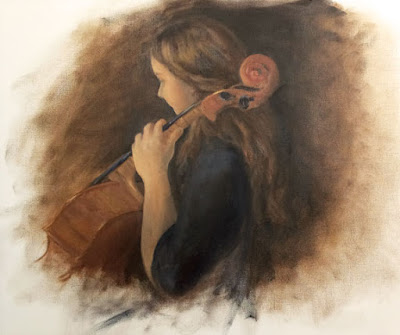 |
| Warm up sketches |
Although I enjoy painting and drawing people occasionally, I don't think of myself as a portrait or figure painter. I tend to do it as an exercise, but the more I've been attending live model sessions, the more I've been noticing people in general; the way the light shines across someone's face, or a particularly interesting-looking person in a crowd. A few times I've seen someone who I desperately wanted to paint, but had no idea how to go up to a perfect stranger and ask, "Can I paint you?”. Er, awkward!
Even though we live in a smaller city in a rural area, we do have a surprisingly good symphony orchestra. At a concert last year I noticed how one of the cello players and her instrument had a perfect combination of lighting, colors and form. Every concert we attended after that, I'd sit there and try to figure out how in the world I could get a chance to paint her. "Just go up and ask her after the concert." my husband would say. Uh yeah, right.
Finally this past November, after a particularly wonderful concert, I figured what have I got to lose? So at the end of the performance while the musicians were packing up their instruments, I pushed my way through the exiting crowd to the base of the stage. I managed to get the cellist's attention and introduced myself, complimented her on that evening's performance, and explained that I was an artist and I wanted to paint her playing the cello. I handed her my business card and told her to check out my website, think about it, and if she was interested, to email me. She didn’t back away from me or call security, so that was a relief, but I was surprised when she sent me an email two days later. She was interested!
Our schedules finally coincided last Saturday and we met at our local art center. This was the first time I’d ever arranged a model for myself, and her first time posing. In a lot of ways this felt like a first date back in high school, with all the awkwardness and worry. I was nervous about what she would think of my art. What if I accidentally offended her with poor painting skills or a less-than-complimentary likeness? I also wanted to make sure she had a positive experience. I knew that holding a pose is hard work and since she was new and volunteering to do this for me, I didn’t want to ask too much so I just told her to practice and I’d work while she played.
We both warmed up with some exercises; me sketching and her tuning up and playing scales, and then we both launched into our respective art forms. I’ve had music on while I’ve painted before, but having someone play live while you are working adds a whole different dimension to the experience. I picked up on the energy of the music and the musician’s movements. I found that I wasn’t thinking - just reacting with my paint. My brushstrokes were much looser than usual. It really was an incredible feeling. It was challenging to paint someone who was constantly in motion, but in hindsight, I think it would have felt very stale if she had held a pose, pretending to play.
 |
Study of Cellist - WIP
16x20 inches, oil on canvas |
Fresh snow was beginning to pile up outside, so we ended the session a
half hour early. My mental energy was starting to lag anyway, after such
an intense bout of painting. I asked her to get in touch with me
sometime if she was ever interested in modeling again. Much to my surprise,
she texted me later that evening and said she would like to! I am definitely looking forward to the next session.
Technical notes: A week after I first approached the cello player at the concert, I saw this article online about asking strangers to model for you. It would’ve been helpful to me to read beforehand, but it also felt good to know I’d navigated the process on my own. I’m sure that not everyone I ask is going to have a positive reaction to me wanting to paint them, but this was certainly a good first experience.
If you are painting someone's likeness, don't forget to consider if you should use a model release contract. Here are a couple of articles on the topic: here and here
During the painting session I used a Thomas Sully palette that I was introduced to during a figure painting class at the Pennsylvania Academy of the Fine Arts with Ted Xaras in 2014.
























